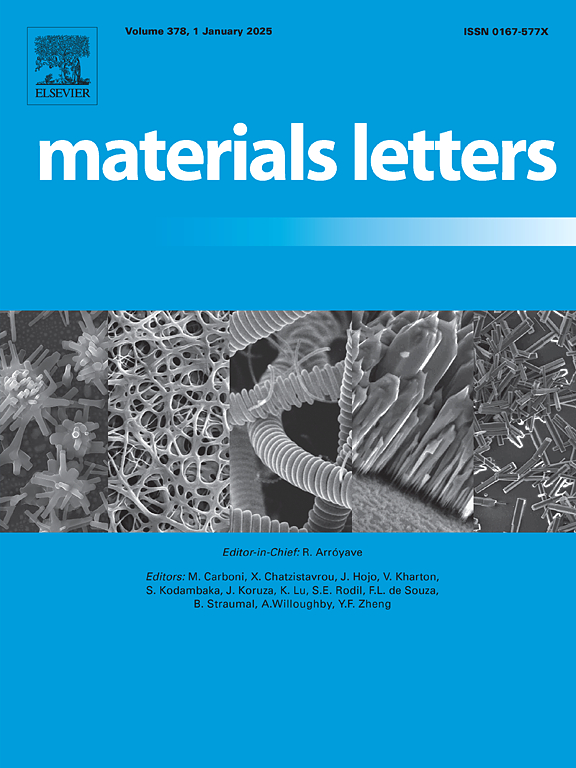Ac-Electrophoretic deposition fabricated LiFePO4 composite cathodes with enhanced diffusion-controlled charge storage for solid-state lithium metal batteries
IF 2.7
4区 材料科学
Q3 MATERIALS SCIENCE, MULTIDISCIPLINARY
引用次数: 0
Abstract
In this study, we report the fabrication and electrochemical analysis of an all-solid-state lithium (Li) metal battery comprising a Li metal anode, a Li1.3Al0.3Ti1.7(PO4)3 (LATP) solid electrolyte, and a LiFePO4 (LFP) cathode deposited via alternating current electrophoretic deposition (AC-EPD) with conductive and structural additives. The use of AC-EPD enables the formation of a uniform, compositionally controlled LFP composite cathode with intimate contact to the solid electrolyte layer. Through a combination of cyclic voltammetry, galvanostatic charge/discharge, we confirm that the charge storage mechanism is predominantly diffusion-controlled with b values of 0.53 (oxidation) and 0.52 (reduction) with a diffusion coefficient of 4.68 × 10−10 cm2/Vs, highlighting the exceptional rate capability and cycle stability. The inclusion of additives facilitates improved electronic conductivity and mechanical integrity of the cathode, enabling stable cycling within the all-solid-state configuration. This work demonstrates the viability of using AC-EPD as a scalable route for fabricating high-quality composite cathodes and provides valuable insight into interfacial transport processes critical for the development of high-performance, solid-state lithium metal batteries.
固态锂金属电池用增强扩散控制电荷存储的交流电泳沉积制备LiFePO4复合阴极
在这项研究中,我们报道了由锂金属阳极、Li1.3Al0.3Ti1.7(PO4)3 (LATP)固体电解质和通过交流电泳沉积(AC-EPD)沉积的LiFePO4 (LFP)阴极组成的全固态锂(Li)金属电池的制备和电化学分析。使用AC-EPD可以形成均匀的,成分可控的LFP复合阴极,与固体电解质层紧密接触。通过循环伏安法和恒流充放电的结合,我们证实了电荷存储机制主要是扩散控制的,b值为0.53(氧化)和0.52(还原),扩散系数为4.68 × 10−10 cm2/Vs,突出了卓越的速率能力和循环稳定性。添加剂的加入有助于提高阴极的电子导电性和机械完整性,实现全固态结构下的稳定循环。这项工作证明了使用AC-EPD作为制造高质量复合阴极的可扩展途径的可行性,并为开发高性能固态锂金属电池的关键界面传输过程提供了有价值的见解。
本文章由计算机程序翻译,如有差异,请以英文原文为准。
求助全文
约1分钟内获得全文
求助全文
来源期刊

Materials Letters
工程技术-材料科学:综合
CiteScore
5.60
自引率
3.30%
发文量
1948
审稿时长
50 days
期刊介绍:
Materials Letters has an open access mirror journal Materials Letters: X, sharing the same aims and scope, editorial team, submission system and rigorous peer review.
Materials Letters is dedicated to publishing novel, cutting edge reports of broad interest to the materials community. The journal provides a forum for materials scientists and engineers, physicists, and chemists to rapidly communicate on the most important topics in the field of materials.
Contributions include, but are not limited to, a variety of topics such as:
• Materials - Metals and alloys, amorphous solids, ceramics, composites, polymers, semiconductors
• Applications - Structural, opto-electronic, magnetic, medical, MEMS, sensors, smart
• Characterization - Analytical, microscopy, scanning probes, nanoscopic, optical, electrical, magnetic, acoustic, spectroscopic, diffraction
• Novel Materials - Micro and nanostructures (nanowires, nanotubes, nanoparticles), nanocomposites, thin films, superlattices, quantum dots.
• Processing - Crystal growth, thin film processing, sol-gel processing, mechanical processing, assembly, nanocrystalline processing.
• Properties - Mechanical, magnetic, optical, electrical, ferroelectric, thermal, interfacial, transport, thermodynamic
• Synthesis - Quenching, solid state, solidification, solution synthesis, vapor deposition, high pressure, explosive
 求助内容:
求助内容: 应助结果提醒方式:
应助结果提醒方式:


